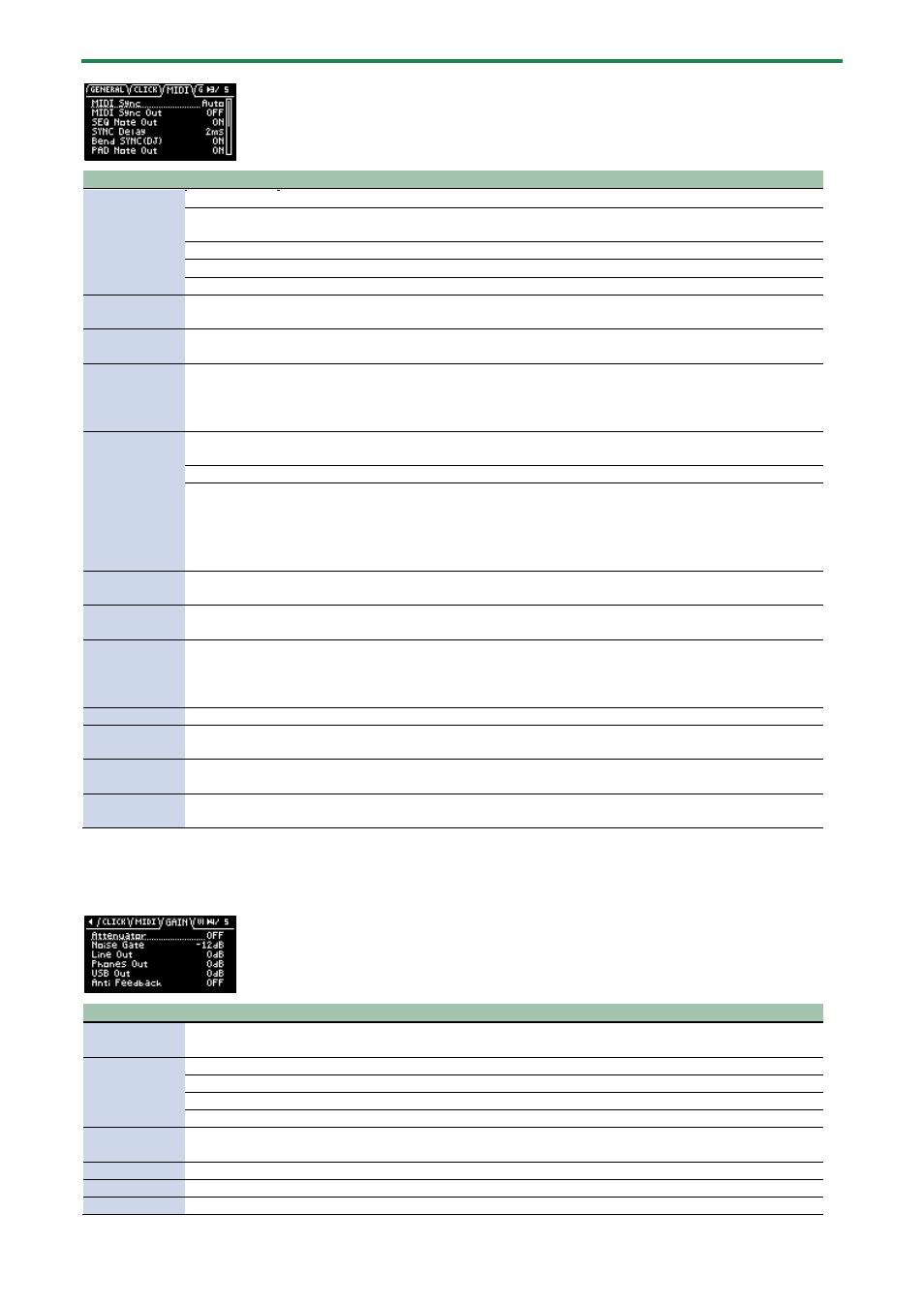Gain – Roland SP-404MKII Creative Sampler and Effector User Manual
Page 125

Appendix
125
Parameter
Value
Explanation
MIDI Sync
Specifies the tempo source.
Auto
The tempo automatically synchronizes to the MIDI clocks if MIDI clocks are input via the
MIDI IN connector or the USB port.
Internal
The tempo specified on this unit is used.
MIDI
The tempo synchronizes to the MIDI clocks received via the MIDI IN connector.
USB
The tempo synchronizes to the MIDI clocks received via the USB port.
MIDI Sync Out OFF, ON
When this is ON, clocks, start and stop are transmitted to the device connected to this
unit’s MIDI OUT connector.
SEQ Note Out OFF, ON
When this is set to “ON”, the note number corresponding to the pattern (pad) is output via
the MIDI OUT connector when the pattern plays back.
SYNC Delay
0–20ms
Adjust this if there is a delay (latency) in sound between your external MIDI device and this
unit.
Larger values make this unit play back at a more delayed timing.
When this is set to “0”, this unit plays and outputs MIDI messages with the same timing.
Bend
SYNC(DJ)
This sets how the MIDI clock output from this unit changes when you press the [BEND-] or [BEND+] pads to
change the playback speed of this unit.
OFF
MIDI clocks are output at a fixed rate.
ON
MIDI clocks outputted from this unit are synchronized with this unit’s playback speed.
With this setting, the tempo of MIDI devices connected externally changes in time with the
playback speed of this unit.
●
If you press the [BEND-] [BEND+] pads while holding down the [REMAIN] button, the
MIDI clocks do not change (the effect is the same as the OFF setting).
PAD Note Out OFF, ON
When this is set to “ON”, note numbers corresponding to the pads are output via the MIDI
OUT connector when you play the pads.
Soft Through
OFF, ON
If this is “ON”, MIDI messages that are input to the MIDI IN connector are output to the MIDI
OUT connector.
USB-MIDI
Thru
OFF, ON
When this is “ON”, MIDI signals that are input via the USB port are output to the MIDI OUT
connector. MIDI signals that are inputted via the MIDI IN connector are also outputted to
the USB port.
The inputted MIDI signals are also transmitted to the internal sound module at that time.
PC Rx
OFF, ON
When this is ON, program change messages are received.
MIDI Mode
A, B
Changes the note number assignment according to the mode you’ve selected.
For details, refer to “
(P.152).”
Pad MIDI
Channels
1/2, 2/3–
9/10, 10/11
Sets the offset value for the MIDI channel.
This setting is enabled when “MIDI Mode” is set to “B”.
Note offset
-11–35
Sets the offset value for the note number.
This setting is enabled when “MIDI Mode” is set to “B”.
GAIN
Parameter
Value
Explanation
Attenuator
OFF, ON
When this is ON, the gain of the audio input from the LINE IN jacks is lowered.
Turn the Attenuator on when the LINE IN input seems to be distorting.
Noise Gate
Reduces the noise floor in the signal input from the LINE IN and INPUT jacks.
OFF
The noise gate is not used.
-9dB, -12dB, -18dB
Reduces the noise floor at the specified level.
-Inf
Reduces the noise floor to the bare minimum.
Anti Feedback OFF, ON
When this is “ON”, the anti-feedback function is enabled for the mic input.
This helps prevent mic feedback.
LINE OUT
0, +6, +12 (dB)
Sets the gain of the audio output from the LINE OUT jacks.
PHONES OUT
-18, -12, -6, 0, +6, +12 (dB) Sets the gain of the audio output from the PHONES OUT jacks.
USB OUT
-24, -12, 0 (dB)
Sets the gain of the audio output from the USB port.